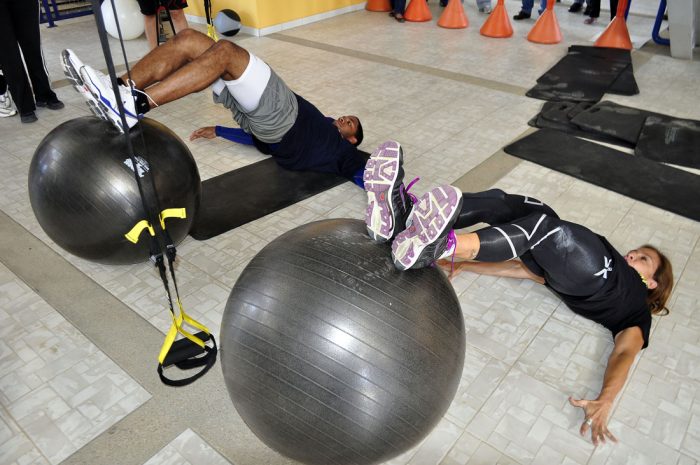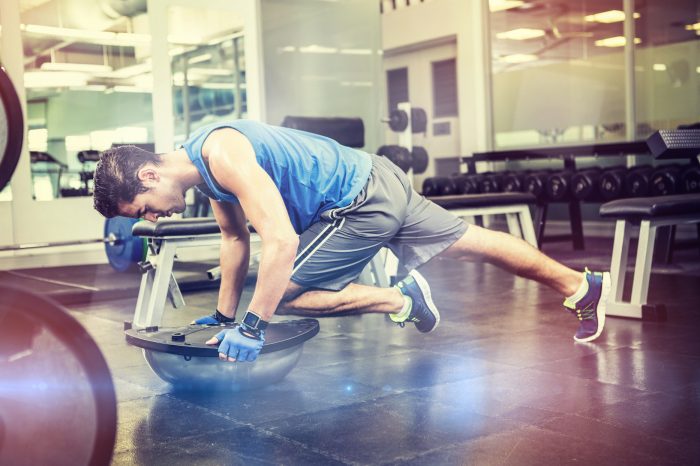In pretty much any large scale commercial gym you might wander into, you’re more or less guaranteed these days to see a number of various inflatable balls, foam blocks, wobble boards and other ‘Unstable Surface’ items of training equipment. But are they of any use for the squash player?
Their popularity has soared in recent years with the ‘functional training’ fad boom, and this popularity has unfortunately seen many otherwise smart athletes and trainers drawn in by the hype with little consideration of what ‘functional training’ actually means, and how balancing on one leg on an upside-down air-filled rubber dome could ever accurately be described as ‘functional’.
The most common and oft-seen unstable surface apparatus is the fit/exercise ball or ‘Swiss Ball’ – basically just a large inflatable plastic ball, with a diameter of anything between 45 and 75cms. Swiss Balls are so-called due to therapists in North America supposedly having seen the work being done in Switzerland in the 60s by specialists using the balls in physical therapy for treating various orthopaedic or medical issues, and then integrating them into their own practices.
Indeed, the use of Swiss Balls, wobble boards, and other unstable surface apparatus continues today to be successfully used in various physiotherapy/rehabilitation exercises and can be useful in certain contexts for rebuilding strength and proprioception. The problem comes when trainers and sportspeople move beyond this and extrapolate to the idea that these tools will also be of similar benefit to otherwise healthy individuals, and even of use in the highly specialised development of strength and power in elite athletes. Unfortunately, there is very little evidence that this is the case.
With any training method that is being used as part of an attempt to enhance the physical attributes associated with a particular sport, one of the key principles is that of ‘Specificity’. For optimal results, any physical training that is done with boosting performance as its goal needs at some level to replicate the demands or actions/movements of the sport in question. Even from the hypothetical viewpoint of someone completely unfamiliar with the nuances of the sport, watching a person practising balancing on a swiss ball should immediately raise the question of just how relevant that exercise could be to squash – or indeed, any type of physical activity outside of performing in a circus. Exercises such as those seen here are undoubtedly impressive feats of balance, but how relevant are they to sports performance?
Indeed, when people talk about ‘balance’ within sport, what they’re often really referring to would be more correctly identified as ‘Stability’ – for example something like maintaining a stable base on a lunge into the corners on a squash court, an action which is best trained by replicating the lunge movement while under load or by utilising similar compound free weights exercises that require multi-planar strength and stability to perform. Even when ‘balance’ is being specifically referred to (as defined by the dictionary as: ‘an even distribution of weight enabling someone or something to remain upright and steady’), the attribute is rarely a limiting factor in performance, and it has been fairly well-established in many studies over the years now to be skill-specific – static balance exercises have very little crossover to the dynamic balance required in a fast-moving, highly active sport such as squash.
 That’s not to say that all unstable surface exercises are completely worthless, however. As well as the rehab and therapy based uses, there are some unstable surface training exercises that can be incorporated into a training programme that are potentially beneficial for mobility (e.g. Hip Circles) and core stability (e.g. Swiss Ball Rollouts).
That’s not to say that all unstable surface exercises are completely worthless, however. As well as the rehab and therapy based uses, there are some unstable surface training exercises that can be incorporated into a training programme that are potentially beneficial for mobility (e.g. Hip Circles) and core stability (e.g. Swiss Ball Rollouts).
There are generally going to be equally efficient and effective ways of training these elements however, without the use of unnecessary additional equipment that isn’t really bringing any additional benefits. Basic large compound exercises such as deadlifts, squats, and lunges will far better replicate the synergistic muscle actions and nerve impulses necessary for maintaining strong and stable full-body movements in the sport of squash. Seeing some of the bizarre activities that go on in gyms with people performing all sorts of weird and wonderful exercises on domes and balls, it is very difficult to reconcile these with the basic movement patterns of squash.
Going back to the principle of specificity, it’s worth remembering that all squash movements are based on an unmoving, stable surface. The floor of a squash court does not move or bend, or wobble, so carrying out exercises on a surface that does any of these things is by very definition no longer specific. There are some sports where there indeed is an ‘unstable surface’ – think sailing, surfing, motocross, and ice-based sports for example, that all require very specialised forms of conditioning that may indeed involve unstable surfaces.
For the squash player however, who is interested in generating force through their muscles to power their way around the squash court, the best way to enhance this force production is by training on solid ground.
Studies show quite clearly that there is actually far LESS force produced by the legs when performing lower body exercises on an inflatable ball/dome for example, due to the difficulties with the surface instability. There is even some evidence that these kinds of exercises can actually increase the risk of injury, and REDUCE power output over time if utilised regularly in a training programme.
 A great article that goes through many of these points and thoroughly deconstructs the use of unstable surface training is ‘BOSU Ball: The Good, Bad, and Ugly’. The author Eric Cressey, is a prominent and very well-respected Athletic Performance/Strength & Conditioning Coach. He was also the lead author of a 2007 research paper titled ‘The Effects of Ten Weeks of Lower-Body Unstable Surface Training on Markers of Athletic Performance’, that was originally published in the Journal of Strength & Conditioning Research (abstract here). He references the findings of this paper a number of times in the article, and I really recommend that anyone interested in the science and theory behind unstable surface training reads it – it is incredibly thorough and well-explained, addressing a number of the most common arguments presented in support of unstable surface training. Don’t be fooled into believing an exercise or training method is the best way, just because you see a lot of people doing it – always try and seek out the relevant research and expert consensus.
A great article that goes through many of these points and thoroughly deconstructs the use of unstable surface training is ‘BOSU Ball: The Good, Bad, and Ugly’. The author Eric Cressey, is a prominent and very well-respected Athletic Performance/Strength & Conditioning Coach. He was also the lead author of a 2007 research paper titled ‘The Effects of Ten Weeks of Lower-Body Unstable Surface Training on Markers of Athletic Performance’, that was originally published in the Journal of Strength & Conditioning Research (abstract here). He references the findings of this paper a number of times in the article, and I really recommend that anyone interested in the science and theory behind unstable surface training reads it – it is incredibly thorough and well-explained, addressing a number of the most common arguments presented in support of unstable surface training. Don’t be fooled into believing an exercise or training method is the best way, just because you see a lot of people doing it – always try and seek out the relevant research and expert consensus.
Gary Nisbet
B.Sc.(Hons), CSCS, NSCA-CPT, Dip. FTST
SquashSkills Fitness & Performance Director
Sign up to the SquashSkills newsletter
Get world class coaching tips, straight to your inbox!